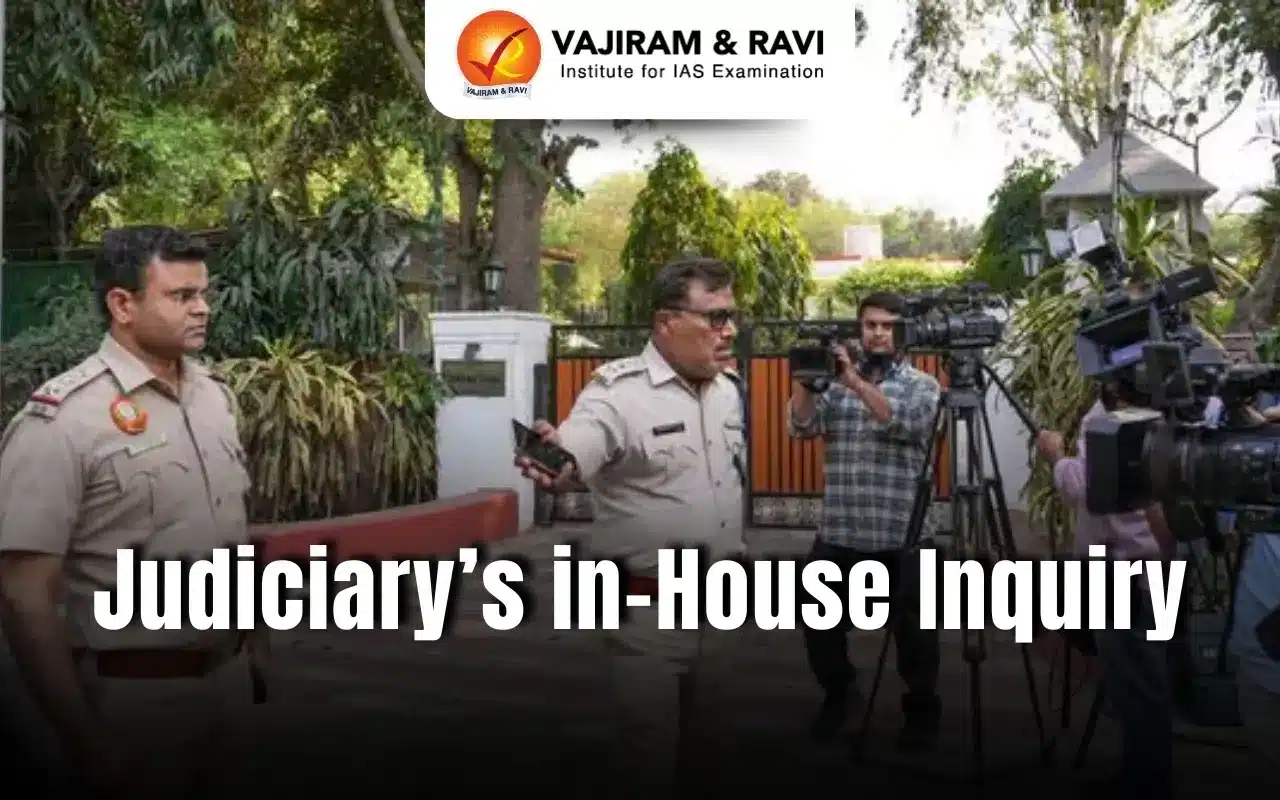What’s in Today’s Article?
- Judiciary’s in-house inquiry Latest News
- Removal of a Judge in India
- In-House Procedure for Judicial Accountability
- Judiciary’s In-House Inquiry FAQs
Judiciary’s in-house inquiry Latest News
- Chief Justice of India (CJI) Sanjiv Khanna has initiated an unprecedented three-member in-house inquiry into Delhi High Court judge Justice Yashwant Varma following allegations that bundles of cash were found at his residence after a fire on March 14.
- The inquiry, distinct from the constitutional impeachment process, will be conducted by Chief Justices Sheel Nagu (Punjab & Haryana HC), G S Sandhawalia (Himachal Pradesh HC), and Justice Anu Sivaraman (Karnataka HC).
Removal of a Judge in India
- Constitutional Provision
- The process for the removal of a Supreme Court judge is outlined in Article 124(4) of the Indian Constitution.
- Article 218 extends the same provisions to High Court judges.
- Grounds for Removal
- A judge can only be removed on two grounds:
- Proved misbehaviour
- Incapacity
- A judge can only be removed on two grounds:
- Impeachment Process
- The removal process requires an impeachment motion in both Lok Sabha and Rajya Sabha.
- At least two-thirds of members present and voting must approve it.
- The number of votes in favour must exceed 50% of the total membership of each House.
- Final Approval
- If Parliament approves the motion, the President issues an order for the judge’s removal.
- If Parliament is dissolved or its term ends, the impeachment motion fails.
In-House Procedure for Judicial Accountability
- Origins of the In-House Procedure
- Complaints against judges are not limited to Parliament. The CJI or a High Court CJ may also examine them.
- The need for an internal mechanism arose in 1995, after financial impropriety allegations against Bombay HC CJ A M Bhattacharjee.
- The SC, in C. Ravichandran Iyer v. Justice A.M. Bhattacharjee (1995), highlighted a gap between bad behaviour and impeachable misbehaviour under Article 124.
- A five-member committee was formed to create an internal process for addressing judicial misconduct.
- The committee submitted its report in October 1997, and the SC adopted it in December 1999.
- Revisions in 2014
- In 2014, a sexual harassment complaint by a Madhya Pradesh judge led the SC to refine the in-house procedure in Additional District and Sessions Judge ‘X’ v. Registrar General High Court of Madhya Pradesh.
- Justices J S Khehar and Arun Mishra outlined a seven-step process.
- Process for Handling Complaints
- Receiving the Complaint
- Complaints may be made to the CJI, a HC CJ, or the President of India.
- The HC CJ or President forwards the complaint to the CJI.
- The CJI may dismiss the complaint if it is deemed not serious.
- Preliminary Inquiry
- The CJI may seek a report from the HC CJ concerned.
- If the HC CJ recommends a deeper probe, the CJI reviews the report and judge’s statement.
- Formation of an Inquiry Committee
- The CJI may form a three-member committee, including:
- Two High Court Chief Justices
- One High Court Judge
- The committee follows natural justice principles and gives the judge an opportunity to explain.
- The CJI may form a three-member committee, including:
- Inquiry and Report Submission
- The committee submits a report to the CJI, stating whether:
- The allegations have merit.
- The misconduct warrants removal proceedings.
- Post-Inquiry Actions
- If the misconduct is not serious, the CJI may advise the judge and place the report on record.
- If the misconduct is serious, the CJI advises the judge to resign or retire.
- If the judge refuses, the CJI directs the HC CJ to stop assigning judicial work.
- If the judge still does not resign, the CJI informs the President and PM, recommending removal proceedings.
- Receiving the Complaint
- Current Relevance
- In Justice Yashwant Varma’s case, CJI Sanjiv Khanna has already directed Delhi HC CJ D K Upadhyaya to stop assigning him judicial work.
Judiciary’s In-House Inquiry FAQs
Q1. What is the judiciary’s in-house inquiry?
Ans. It is an internal process to examine judicial misconduct, separate from the constitutional impeachment procedure.
Q2. What are the grounds for a judge’s removal in India?
Ans. A judge can be removed only for proved misbehaviour or incapacity, as per Article 124(4).
Q3. How does the in-house inquiry process work?
Ans. It involves a three-member committee investigating allegations and recommending actions, including resignation or impeachment.
Q4. What happens if a judge refuses to resign?
Ans. The CJI may stop assigning them work and inform the President and PM to initiate removal proceedings.
Q5. How does impeachment of judges take place in India?
Ans. Parliament must approve it with a two-thirds majority in both houses, after which the President issues the removal order.
Source: IE
Last updated on June, 2025
→ UPSC Notification 2025 was released on 22nd January 2025.
→ UPSC Prelims Result 2025 is out now for the CSE held on 25 May 2025.
→ UPSC Prelims Question Paper 2025 and Unofficial Prelims Answer Key 2025 are available now.
→ UPSC Calendar 2026 is released on 15th May, 2025.
→ The UPSC Vacancy 2025 were released 1129, out of which 979 were for UPSC CSE and remaining 150 are for UPSC IFoS.
→ UPSC Mains 2025 will be conducted on 22nd August 2025.
→ UPSC Prelims 2026 will be conducted on 24th May, 2026 & UPSC Mains 2026 will be conducted on 21st August 2026.
→ The UPSC Selection Process is of 3 stages-Prelims, Mains and Interview.
→ UPSC Result 2024 is released with latest UPSC Marksheet 2024. Check Now!
→ UPSC Toppers List 2024 is released now. Shakti Dubey is UPSC AIR 1 2024 Topper.
→ Also check Best IAS Coaching in Delhi






















